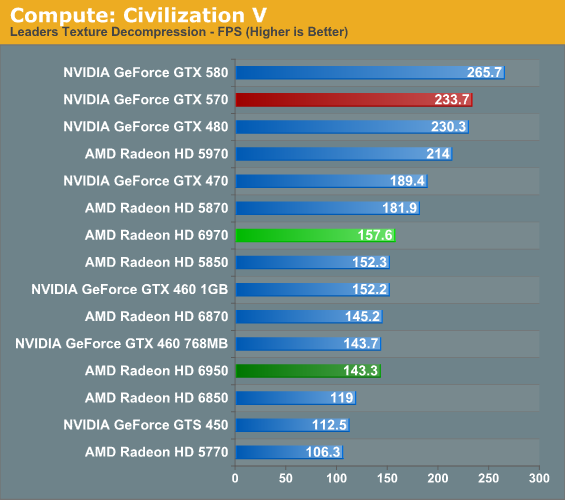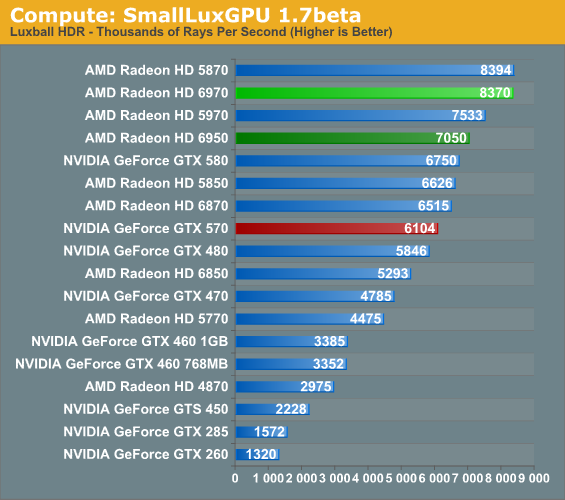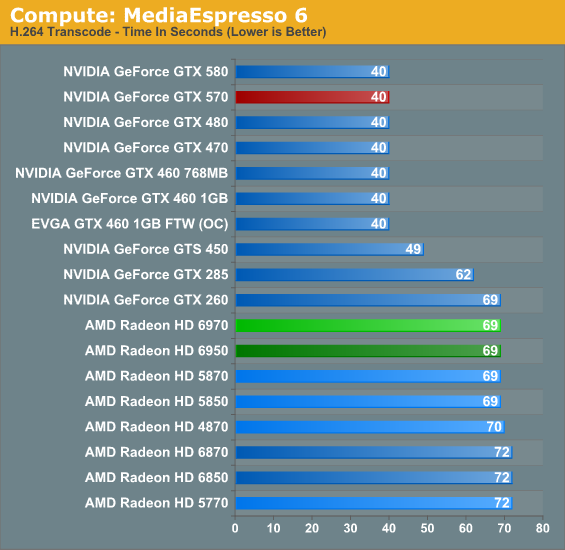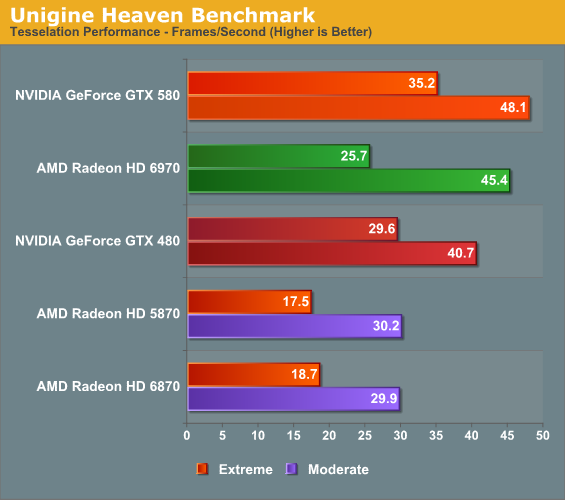AMD's Radeon HD 6970 & Radeon HD 6950: Paving The Future For AMD
by Ryan Smith on December 15, 2010 12:01 AM ESTCompute & Tessellation
Moving on from our look at gaming performance, we have our customary look at compute performance, bundled with a look at theoretical tessellation performance. This will give us our best chance to not only look at the theoretical aspects of AMD’s tessellation improvements, but to isolate shader performance to see whether AMD’s theoretical performance advantages and disadvantages from VLIW4 map out to real world scenarios.
Our first compute benchmark comes from Civilization V, which uses DirectCompute to decompress textures on the fly. Civ V includes a sub-benchmark that exclusively tests the speed of their texture decompression algorithm by repeatedly decompressing the textures required for one of the game’s leader scenes.

Civilization V’s compute shader benchmark has always benefitted NVIDIA, but that’s not the real story here. The real story is just how poorly the 6900 series does compared to the 5870. The 6970 barely does better than the 5850, meanwhile the 6950 is closest to NVIDIA’s GTX 460, the 768MB version. If what AMD says is true about the Cayman shader compiler needing some further optimization, then this is benchmark where that’s readily apparent. As an application of GPU computing, we’d expect the 6900 series to do at least somewhat better than the 5870, not notably worse.
Our second GPU compute benchmark is SmallLuxGPU, the GPU ray tracing branch of the open source LuxRender renderer. While it’s still in beta, SmallLuxGPU recently hit a milestone by implementing a complete ray tracing engine in OpenCL, allowing them to fully offload the process to the GPU. It’s this ray tracing engine we’re testing.

Unlike Civ 5, SmallLuxGPU’s performance is much closer to where things should be theoretically. Even with all of AMD’s shader changes both the 5870 and 6970 have a theoretical 2.7 TFLOPs of compute performance, and SmallLuxGPU backs up that number. The 5870 and 6970 are virtually tied, exactly where we’d expect our performance to be if everything is running under reasonably optimal conditions. Note that this means that the 6950 and 6970 both outperform the GTX 580 here, as SmallLuxGPU does a good job setting AMD’s drivers up to extract ILP out of the OpenCL kernel it uses.
Our final compute benchmark is Cyberlink’s MediaEspresso 6, the latest version of their GPU-accelerated video encoding suite. MediaEspresso 6 doesn’t currently utilize a common API, and instead has codepaths for both AMD’s APP and NVIDIA’s CUDA APIs, which gives us a chance to test each API with a common program bridging them. As we’ll see this doesn’t necessarily mean that MediaEspresso behaves similarly on both AMD and NVIDIA GPUs, but for MediaEspresso users it is what it is.

MediaEspresso 6 quickly gets CPU bottlenecked when paired with a faster GPU, leading to our clusters of results. For the 6900 series this mostly serves as a sanity check, proving that transcoding performance has not slipped even with AMD’s new architecture.
At the other end of the spectrum from GPU computing performance is GPU tessellation performance, used exclusively for graphical purposes. For the Radeon 6900 series, AMD significantly enhanced their tessellation by doubling up on tessellation units and the graphic engines they reside in, which can result in up to 3x the tessellation performance over the 5870. In order to analyze the performance of AMD’s enhanced tessellator, we’re using the Unigine Heaven benchmark and Microsoft’s DirectX 11 Detail Tessellation sample program to measure the tessellation performance of a few of our cards.

Since Heaven is a synthetic benchmark at the moment (the DX11 engine isn’t currently used in any games) we’re less concerned with performance relative to NVIDIA’s cards and more concerned with performance relative to the 5870. So with AMD’s tessellation improvements we see the 6970 shoot to life on this benchmark, coming in at nearly 50% faster than the 5870 at both moderate and extreme tessellation settings. This is actually on the low end of AMD’s theoretical tessellation performance improvements, but then even the geometrically overpowered GTX 580 doesn’t get such clear gains. But on that note while the 6970 does well at moderate tessellation levels, at extreme tessellation levels it still falls to the more potent GTX 400/500 series.

As for Microsoft’s DirectX 11 Detail Tessellation Sample program, a different story is going on. The 6970 once again shows significant gains over the 5870, but this time not against the 6870. With the 6870 implementing AMD’s tessellation factor optimized tessellator, most of the 6970’s improvements are already accounted for here. At the same time we can still easily see just how much of an advantage NVIDIA’s GTX 400/500 series still has in the theoretical tessellation department.










168 Comments
View All Comments
Roland00Address - Wednesday, December 15, 2010 - link
1) The architecture article is something that can be written before hand, or written during benching (if the bench is on a loop). It has very little "cramming" to get out right after a NDA ends. Anand knows this info for a couple of weeks but can't discuss it due to NDAs. Furthermore the reason anandtech is one of the best review sites on the net is the fact they do go into the architecture details. The architecture as well as the performance benchmarks is the reason I come to anandtech instead of other review sites as my first choice.2) The spelling and grammar errors is a common thing at anandtech, this is nothing new. That said I can't complain for my spelling and grammar is far worse than Ryan's.
If you don't like the style of the review go somewhere else.
Ryan Smith - Wednesday, December 15, 2010 - link
1) That's only half true. AMD told us the basics about the 6900 series back in October, but I never had full access to the product information (and more importantly the developers) until 1 week ago. So this entire article was brought up from scratch in 1 week.It's rare for us to get too much access much earlier than that; the closest thing was the Fermi launch where NVIDIA was willing to talk about the architecture months in advance. Otherwise that's usually a closely held secret in order to keep the competition from having concrete details too soon.
Dracusis - Wednesday, December 15, 2010 - link
Neither the AMD 6xxx series or Nvidia's 5xx series have been added. Would like to see how my 4870x2 stack up against this latest generation and weather or not it's worth upgrading.Makaveli - Wednesday, December 15, 2010 - link
The Canadian pricing on these cards are hilarious.Ncix is taking preorder for the 6970 at $474.
While they sell the 570 for $379.
Can someone explain to me why I would pay $100 more for the radeon when the 570 gives equal performance?
Are these retailers that retarded?
stangflyer - Thursday, December 16, 2010 - link
They will price the 6950/6970 high for a few days to get the boys that bleed red and have to have the new cards right away to pay top dollar for the card.After a week they will probably be about the same price.
Ryan Smith - Thursday, December 16, 2010 - link
Bench will be up to date by the start of next week.Paladin1211 - Thursday, December 16, 2010 - link
Whats wrong with you rarson? Do you even know whats the difference between "Graphics card review", "Performance review", "Performance Preview"? I dont know how good your grammar and spelling are, but they dont matter as long as you cant understand the basic meaning of the words.Most of the sites will tell you about WHAT, but here at AnandTech, you'll truly find out WHY and HOW. Well, of course, you can always go elsewhere try to read some numbers instead of words.
Keep up the good works, Ryan.
Belard - Thursday, December 16, 2010 - link
The 3870 and 3850 were the TOP end for ATI, as was the 4800 and the 5800. Their relationship of model numbers do not have anything to do with the status of Nvidia.When the 3870 was brand new, what was the HIGHEST end card ATI had back then? Oh yeah, the 3870!
4800 is over the 3870, easily.
4600 replaced the 3800
The 5800s replaces the 4800s... easily.
the 5700s kind of replaced the 4800s.
The 6800s replaces the 5700 & 5800s, the 6900s replace the 5800s, but not so much on performance.
I paid $90 for my 4670 and a much better value than the $220 3870 since both cards perform almost the same.
AmdInside - Thursday, December 16, 2010 - link
I can't think of a single website that has better hardware reviews, at least for computer technology than Anandtech. Ryan, keep up the great work.George.Zhang - Thursday, December 16, 2010 - link
BTW, HD6950 looks great and affordable for me.